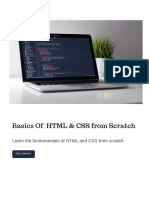Ultimate HTML CSS Guide
Uploaded by
osyagbatacUltimate HTML CSS Guide
Uploaded by
osyagbatacThe Ultimate Guide to HTML and CSS
A beginner-friendly guide to web development
1. Introduction to Coding
Coding is the process of writing instructions for computers. HTML and CSS are the foundation of
web development. HTML structures content, while CSS styles and enhances the design.
2. Basics of HTML
HTML (HyperText Markup Language) uses tags to structure a webpage. Below is a basic example:
<!DOCTYPE html>
<html>
<head>
<title>My First Page</title>
</head>
<body>
<h1>Welcome to My Website</h1>
<p>This is a simple paragraph.</p>
</body>
</html>
3. HTML Forms
Forms allow users to input data. Example of a basic form:
<form>
<label for="name">Name:</label>
<input type="text" id="name" name="name"><br>
<label for="email">Email:</label>
<input type="email" id="email" name="email"><br>
<input type="submit" value="Submit">
</form>
4. HTML Tables
Tables are used to display structured data. Example:
<table border="1">
<tr>
<th>Name</th>
<th>Age</th>
</tr>
<tr>
<td>Alice</td>
<td>25</td>
</tr>
</table>
5. Basics of CSS
CSS (Cascading Style Sheets) enhances the visual presentation of HTML pages.
body {
background-color: lightblue;
font-family: Arial, sans-serif;
}
h1 {
color: navy;
text-align: center;
}
6. Advanced CSS (Flexbox & Grid)
Flexbox and Grid help create responsive layouts. Example of Flexbox:
div {
display: flex;
justify-content: center;
align-items: center;
}
Example of CSS Grid:
div {
display: grid;
grid-template-columns: auto auto;
gap: 10px;
}
7. Mini Project: Simple Web Page
Let's create a simple webpage with HTML and CSS.
<!DOCTYPE html>
<html>
<head>
<title>My Portfolio</title>
<link rel="stylesheet" type="text/css" href="style.css">
</head>
<body>
<h1>Welcome to My Portfolio</h1>
<p>I am learning HTML and CSS.</p>
</body>
</html>
body {
font-family: Arial, sans-serif;
background-color: #f4f4f4;
text-align: center;
}
h1 {
color: darkblue;
}
8. Conclusion & Next Steps
Congratulations! You've learned the basics of HTML and CSS. Next, practice building small projects
and explore JavaScript for interactive web pages.
You might also like
- Murach's HTML5 and CSS3 3rd Edition (2015)100% (4)Murach's HTML5 and CSS3 3rd Edition (2015)703 pages
- Presentation on Summer Internship Training on WEB DEVELOPMENTNo ratings yetPresentation on Summer Internship Training on WEB DEVELOPMENT18 pages
- Slidesgo Mastering Web Development A Comprehensive Guide To HTML and Css 20241113145615v8WHNo ratings yetSlidesgo Mastering Web Development A Comprehensive Guide To HTML and Css 20241113145615v8WH14 pages
- WEB TECHNOLOGY_39072812_2025_01_23_16_04No ratings yetWEB TECHNOLOGY_39072812_2025_01_23_16_0435 pages
- Learn HTML and CSS From Scratch - 10 Easy StepsNo ratings yetLearn HTML and CSS From Scratch - 10 Easy Steps1 page
- Web Development - Level 1 Using (HTML 5, Cc, Java Script)No ratings yetWeb Development - Level 1 Using (HTML 5, Cc, Java Script)3 pages
- Web Application Development Notes With AnswersNo ratings yetWeb Application Development Notes With Answers6 pages
- 5f539d517b806737a1bb7e14 Web DevelopmentNo ratings yet5f539d517b806737a1bb7e14 Web Development1 page
- Basics of HTML and Css From Scratch PDFNo ratings yetBasics of HTML and Css From Scratch PDF20 pages



























































